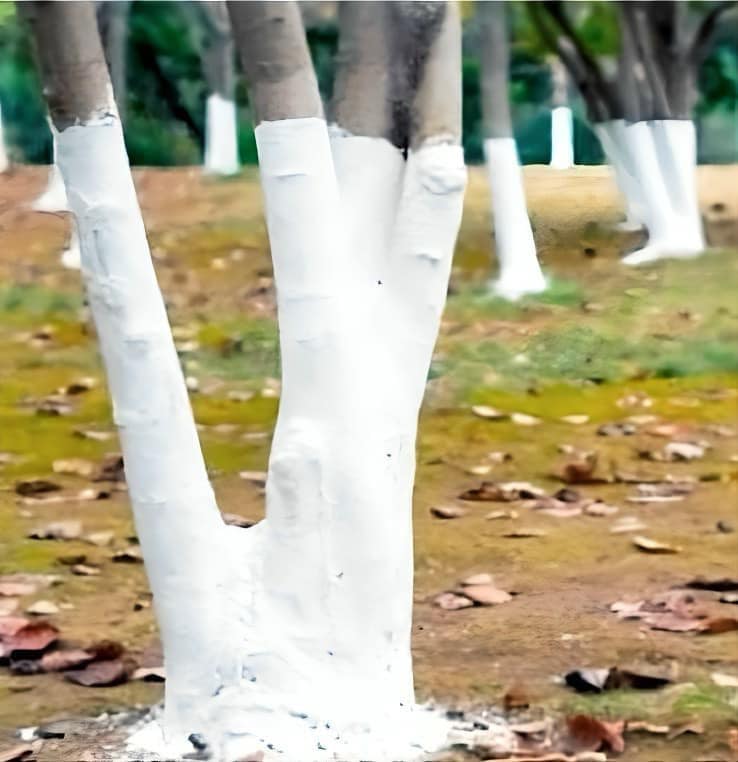If you’ve ever come across trees with their trunks painted white, you might have found yourself wondering what it’s all about. Is it some sort of artistic statement? A marker for property boundaries? Or perhaps a warning sign? As it turns out, the answer is far more practical and grounded in science than you might expect.

The internet has made it easier than ever to explore and understand the oddities around us. With just a few clicks, we can uncover the reasoning behind countless phenomena, from the symbolism of stars painted on barns to the curious presence of square waves on the ocean’s surface. The practice of painting tree trunks white is one such mystery, and thanks to a little digging, we now know why this happens.
Let’s start with a bit of background. Trees are a vital part of our ecosystem, and their health is important not only for the environment but also for the communities they serve. You might have noticed other markings on trees before. For example, trees marked with an orange dot are often slated for removal, while purple markings can indicate private property boundaries. These color-coded signs serve specific purposes, and the same can be said for white paint on tree trunks.
So, why are tree trunks painted white? Surprisingly, the answer lies in protecting trees from sun damage. Yes, trees can get sunburned—just like people. During the winter, this phenomenon, often referred to as “sunscald,” becomes particularly problematic. When the sun’s rays hit a tree’s bark during the day, they can warm it up, causing the bark to expand. Then, as temperatures drop sharply at night, the bark cools and contracts. This rapid change can cause the bark to split, leaving the tree vulnerable to disease, pests, and structural damage.
Enter white paint, a simple yet effective solution. By painting the lower portion of a tree’s trunk with a thin layer of white paint, sunlight is reflected away from the surface, keeping the bark from heating up too much during the day. This helps to reduce the risk of splitting and ensures the tree remains healthy throughout the winter months. The practice is particularly common in orchards and other agricultural areas where tree health directly impacts productivity.
But why white paint specifically? The answer is rooted in physics. White is a highly reflective color that effectively bounces sunlight away from surfaces. By applying this reflective layer, the tree’s trunk stays cooler, even under direct sunlight. Additionally, the paint acts as a protective barrier against insects and fungal infections, providing an added layer of defense against environmental stressors.
This practice is not new. Farmers and horticulturists have been using white paint on tree trunks for decades, if not longer. While it might seem unusual to those unfamiliar with the method, it’s a tried-and-true strategy for preserving the health of trees in harsh climates. The paint itself is usually a diluted mixture of water and latex-based paint, designed to be safe for the tree while providing the desired protective effects.
The sight of white-painted trees might still raise questions among casual observers, but for those in the know, it’s a sign of proactive care and attention. It’s a reminder that even the simplest solutions can have a big impact when it comes to protecting our natural resources.
The concept of sunscald might sound peculiar at first. After all, trees have been growing under the sun for millennia, so why do they suddenly need this extra layer of protection? The answer lies in the changes we’ve made to their environment. Urbanization, deforestation, and shifts in agricultural practices have altered the conditions trees face, making them more susceptible to sun damage. In some cases, trees in orchards or urban areas may have been pruned or thinned, leaving their trunks more exposed to direct sunlight than they would be in a dense forest.
It’s fascinating to think about the lengths we go to in order to protect trees, given their importance to our environment and livelihoods. Whether they’re providing shade, producing fruit, or simply enhancing the beauty of a landscape, trees play an integral role in our lives. Understanding and appreciating practices like painting trunks white helps us recognize the efforts taken to ensure their health and longevity.
So, the next time you spot a tree with its trunk painted white, you’ll know it’s not just an aesthetic choice or a random act. It’s a deliberate and thoughtful measure to protect that tree from the harsh effects of sun exposure and temperature changes. Who knew something so simple could make such a difference? If you’d heard of this practice before or have seen it in action, let us know your thoughts!





